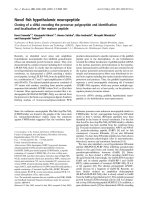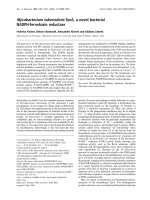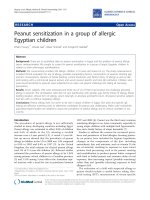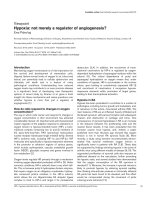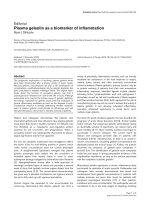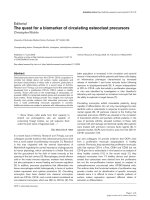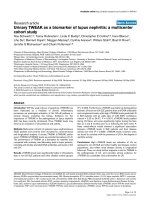Báo cáo y học: "Hypoxia: not merely a regulator of angiogenesis" ppt
Bạn đang xem bản rút gọn của tài liệu. Xem và tải ngay bản đầy đủ của tài liệu tại đây (45.5 KB, 3 trang )
75
HIF = hypoxia-inducible factor; RA = rheumatoid arthritis; VEGF = vascular endothelial growth factor.
Available online />Introduction
Maintaining oxygen homeostasis is of vital importance for
the survival and development of mammalian cells.
Hypoxia (below-normal levels of oxygen in air, blood and
tissue) can potentially lead to cellular dysfunction and
ultimately cell death and is a feature of many
pathological conditions. Understanding how reduced
oxygen levels may contribute to or even promote disease
is a significant facet of developing new therapeutic
options. A recent study by Cramer et al. gives a fresh
insight into these mechanisms and raises questions over
whether hypoxia is more than just a regulator of
angiogenesis [1].
How do cells respond to changes in oxygen
concentration?
The way in which cells ‘sense’ and respond to changes in
oxygen concentration in their environment has attracted
considerable interest. An important and well-characterised
master regulator of the adaptive response to alterations in
oxygen tension is hypoxia-inducible factor (HIF), a trans-
criptional complex containing two (α and β) members of
the basic-helix-loop-helix PAS (period-aryl hydrocarbon
nuclear receptor translocator-single minded) family. Several
HIF-α isoforms exist, including HIF-1α and HIF-2α. HIF
molecules bind specifically to hypoxia-responsive elements
in the promoter or enhancer regions of various genes,
which include erythropoietin, vascular endothelial growth
factor (VEGF), glycolytic enzymes and genes involved in
iron metabolism [2].
Oxygen levels regulate HIF primarily through a mechanism
involving oxygen-dependent proteolysis of HIF-α [3]. Under
normoxic conditions, HIF-α subunits have a very short half-
life. This is because prolyl 4-hydroxylase domain enzymes,
that require oxygen as an obligatory cosubstrate, hydroxy-
late conserved proline residues in the HIF-α subunit,
which allows the von Hippel-Lindau E3 ubiquitin ligase
complex to bind to HIF-α and target it for proteasomal
destruction [2,4]. In addition, the recruitment of trans-
criptional coactivators by HIF-α is regulated by oxygen-
dependent hydroxylation of asparaginyl residues within the
subunit [5]. The critical dependence of prolyl and
asparaginyl hydroxylation on oxygen means that, under
conditions of hypoxia, HIF-α accumulates in the nucleus
where, upon binding to constitutively expressed HIF-1β
and recruitment of coactivators, it recognizes hypoxia-
responsive elements within promoters of target genes,
leading to their transcriptional activation.
Hypoxia in RA
Hypoxia has been postulated to contribute to a number of
pathologies, including tumour growth and metastasis, and,
of relevance to this article, rheumatoid arthritis (RA). The
main features of RA are an inflamed, heavily infiltrated and
thickened synovium, with pannus formation and subsequent
invasion and destruction of cartilage and bone. One
consequence of synovial hyperplasia in RA is an increase
in the distance between the proliferating cells and the
nearest blood vessels. It has been postulated that this
increase causes local hypoxia, and, indeed, a paper
published more than 30 years ago showed that oxygen
tension is low in human RA synovial fluids [6]. More
recently, a study using sensitive microelectrodes demon-
strated that synovial membrane oxygen tension is
significantly lower in patients with RA [7,8]. These data
are supported by findings showing hypoxia in the joints of
arthritic mice using different models of disease [9,10]. The
augmented proliferation of synovial cells also imposes an
additional demand on the vasculature, further promoting
the hypoxic state, and several studies have demonstrated
that the oxygen consumption of the RA synovium is
elevated [11]. Moreover, the increase in synovial volume is
likely to promote hypoxia, by reducing synovial capillary
flow. Resting intra-articular pressure in chronically inflamed
RA joints has been found to be elevated, and this effect
would be compounded during the movement of joints
inducing acute ischemia [12].
Viewpoint
Hypoxia: not merely a regulator of angiogenesis?
Ewa Paleolog
Kennedy Institute of Rheumatology & Division of Surgery, Anaesthetics and Intensive Care, Faculty of Medicine, Imperial College, London, UK
Corresponding author: Ewa Paleolog (e-mail: )
Received: 6 Feb 2004 Accepted: 12 Feb 2004 Published: 8 Mar 2004
Arthritis Res Ther 2004, 6:75-77 (DOI 10.1186/ar1160)
© 2004 BioMed Central Ltd (Print ISSN 1478-6354; Online ISSN 1478-6362)
76
Arthritis Research & Therapy Vol 6 No 2 Paleolog
As expected, given that the RA joint is profoundly hypoxic,
HIF-1α was shown to be expressed by macrophages in
the RA synovium, but was absent from healthy synovial
tissue [13]. Studies using an animal model of arthritis
demonstrated that HIF-1α and another transcription factor,
Ets-1, colocalised with areas of hypoxia in inflamed joints
[9]. More recently, HIF-2α was also described in RA [14].
It is generally thought that the primary consequence of the
hypoxic RA synovial environment is enhanced angio-
genesis, since VEGF is an important HIF-inducible molecule.
Within a few hours of exposing different cell cultures to
hypoxia, VEGF mRNA levels are dramatically increased
[15]. For example, my colleagues and I have reported that
RA synovial cells respond to hypoxia by upregulating
VEGF [16]. Certainly, VEGF is expressed in RA and the
synovial vascular density is altered [16]. However, the
recent publication from Napoleone Ferrara’s and Randall
Johnson’s groups has raised the highly intriguing
possibility that hypoxia and HIFs may have other roles in
RA besides the regulation of angiogenesis [1].
Investigating the functions of HIF-1
αα
In this seminal study by Cramer et al., targeted cre-loxP-
mediated deletion of HIF-1α in myeloid lineage cells
achieved over 75% HIF-1α deletion efficiency in macro-
phages and granulocytes [1]. Unlike the embryonic
lethality seen with HIF-1α knockout animals [17], mice
lacking HIF-1α in only neutrophils and monocytes were
without obvious phenotype under normal conditions. As
expected, peritoneal macrophages failed to upregulate
VEGF under hypoxic conditions. Macrophages have the
capacity to switch from an aerobic to an anaerobic
glycolytic pathway for ATP production, but deletion of HIF-
1α resulted in an inability to upregulate molecules involved
in glycolysis (phosphoglycerate kinase and the glucose
transporter Glut-1). Furthermore, loss of HIF-1α was
associated with impaired macrophage aggregation and
migration. Although the RA synovium is hypoxic, it is
unclear whether oxygen tension may differ spatially across
the tissue. Conventionally, it has been thought that the
fibroblasts at the leading edge of the invasive pannus are
most hypoxic, since these cells are furthest from the
synovial blood vessels. However, the RA synovium is
infiltrated by many cells of lympho-haematopoietic origin
including macrophages, which are therefore also likely to
be exposed to low oxygen levels. This is supported by the
observation that CD68-positive cells in RA express HIF-
1α [13]. Indeed it is relevant that, in the RA synovium,
glucose oxidation via an anaerobic, rather than aerobic,
pathway has been reported, suggesting that under
conditions of hypoxia in RA macrophages turn on a
survival response by switching to anaerobic glycolysis
[18]. Thus, in RA, increased levels of HIF-1α may not only
induce VEGF expression but also promote macrophage
survival and retention.
Subsequent experiments in the study by Cramer et al.
addressed whether conditional loss of HIF-1α has
functional consequences on inflammatory responses in
vivo [1]. Using a model of phorbol ester-induced acute
inflammation in the ear, dramatically reduced inflammation
(shown as diminished CD45-positivity) and decreased
oedema were shown in HIF-1α-deficient animals, paralleled
by reduced myeloperoxidase activity in tissue homo-
genates. Crucially, mice with conditional deletion of VEGF
were strikingly different to those lacking HIF-1α, exhibiting
instead quite extensive infiltration, although with reduced
oedema. This suggests that the reduced inflammation in
HIF-1α conditional knockouts is not simply due to
decreased VEGF expression. In a model of chronic
cutaneous inflammation, leukocyte trafficking was also
abrogated in animals lacking HIF-1α in myeloid cells.
The study most relevant to RA in the Cramer et al.
publication involved the use of a murine model of arthritis
[1]. KRN T cell receptor transgenic mice were crossed
with NOD mice and arthritis was induced by serum
transfer. This led to joint inflammation, oedema and
destruction of bone and cartilage. Importantly, in HIF-1α
conditional knockout animals, development of arthritis was
significantly reduced, with diminished ankle swelling and
decreased synovial infiltration and joint destruction. The
mechanism involved in the reduced inflammation seen in
these knockouts is not clear, but is likely to involve
macrophages losing the ability to maintain energy
homeostasis, thus impairing subsequent responses such
as adhesion and migration.
Advancing our understanding of RA
It is well known that hypoxia and synovial infiltration are
seen in RA. The observations described in the study by
Cramer et al. extend our awareness by suggesting that
HIFs regulate not only angiogenesis, but also inflammation
(both acute and chronic) and, in particular, the inflam-
matory cascade in RA [1]. It is of significance that in
parallel to the oxygen-dependent pathway, HIFs may also
be regulated by receptor-mediated signals, although this
pathway is less well understood [19]. These more subtle
changes in HIF-α levels and/or transcriptional activation
are stimulated by growth factors and cytokines such as
TNFα and IL-1, both of which play vital roles in RA
pathogenesis [20–22]. Interestingly, in synovial
fibroblasts, IL-1 appears to increase mRNA for HIF-1α
[23]. HIF may thus represent an important convergence
point, integrating cellular responses to low oxygen tension
and to inflammatory cytokines, and regulating both angio-
genesis and inflammation. In RA, based on the study by
Cramer et al., upregulation of HIFs, as a result of both
local hypoxia and increased proinflammatory cytokines,
may promote macrophage infiltration and survival and
hence the inflammatory cascade. More broadly, this study
indicates that hypoxia may be intimately involved in the
77
upregulation of inflammation in a host of diseases in which
oxygen tension is reduced, including psoriasis, athero-
sclerosis, RA and malignancies. Consequently,
interrupting the HIF pathway could not only interfere with
angiogenesis, but also directly reduce inflammation and
cell trafficking, making it a potentially significant target in
the development of new therapies for these diseases.
Competing interests
None declared.
References
1. Cramer T, Yamanishi Y, Clausen BE, Forster I, Pawlinski R,
Mackman N, Haase VH, Jaenisch R, Corr M, Nizet V, Firestein GS,
Gerber HP, Ferrara N, Johnson RS: HIF-1alpha is essential for
myeloid cell-mediated inflammation. Cell 2003, 112:645-657.
2. Semenza GL: HIF-1, O(2), and the 3 PHDs: how animal cells
signal hypoxia to the nucleus. Cell 2001, 107:1-3.
3. Masson N, Ratcliffe PJ: HIF prolyl and asparaginyl hydroxylases
in the biological response to intracellular O
2
levels. J Cell Sci
2003, 116:3041-3049.
4. Jaakkola P, Mole DR, Tian YM, Wilson MI, Gielbert J, Gaskell SJ,
Kriegsheim A, Hebestreit HF, Mukherji M, Schofield CJ, Maxwell
PH, Pugh CW, Ratcliffe PJ: Targeting of HIF-alpha to the von
Hippel-Lindau ubiquitylation complex by O
2
-regulated prolyl
hydroxylation. Science 2001, 292:468-472.
5. Lando D, Peet DJ, Whelan DA, Gorman JJ, Whitelaw ML:
Asparagine hydroxylation of the HIF transactivation domain a
hypoxic switch. Science 2002, 295:858-861.
6. Lund-Olesen K: Oxygen tension in synovial fluids. Arthritis
Rheum 1970, 13:769-776.
7. Taylor PC: VEGF and imaging of vessels in rheumatoid arthri-
tis. Arthritis Res 2002, 4 (Suppl 3):S99-S107.
8. Taylor P, Miotla JM, Etherington P, Winlove P, Young Y, Paleolog
E, Maini RN: VEGF release is associated with hypoxia in
inflammatory arthritis [abstract]. Arthritis Rheum 2000, 43
Suppl 9:S296.
9. Peters CL, Morris CJ, Mapp PI, Blake DR, Lewis CE, Winrow VR:
The transcription factors hypoxia-inducible factor 1alpha and
Ets-1 colocalize in the hypoxic synovium of inflamed joints in
adjuvant-induced arthritis. Arthritis Rheum 2004, 50:291-296.
10. Etherington PJ, Winlove P, Taylor P, Paleolog E, Miotla JM: VEGF
release is associated with reduced oxygen tensions in experi-
mental inflammatory arthritis. Clin Exp Rheumatol 2002, 20:
799-805.
11. Stevens CR, Blake DR, Merry P, Revell PA, Levick JR: A compar-
ative study by morphometry of the microvasculature in
normal and rheumatoid synovium. Arthritis Rheum 1991, 34:
1508-1513.
12. Jawed S, Gaffney K, Blake DR: Intra-articular pressure profile
of the knee joint in a spectrum of inflammatory arthropathies.
Ann Rheum Dis 1997, 56:686-689.
13. Hollander AP, Corke KP, Freemont AJ, Lewis CE: Expression of
hypoxia-inducible factor 1alpha by macrophages in the rheuma-
toid synovium: implications for targeting of therapeutic genes to
the inflamed joint. Arthritis Rheum 2001, 44:1540-1544.
14. Giatromanolaki A, Sivridis E, Maltezos E, Athanassou N, Papa-
zoglou D, Gatter KC, Harris AL, Koukourakis MI: Upregulated
hypoxia inducible factor-1alpha and -2alpha pathway in
rheumatoid arthritis and osteoarthritis. Arthritis Res Ther 2003,
5:R193-R201.
15. Shweiki D, Neeman M, Itin A, Keshet E: Induction of vascular
endothelial growth factor expression by hypoxia and by
glucose deficiency in multicell spheroids: implications for
tumor angiogenesis. Proc Natl Acad Sci USA 1995, 92:768-
772.
16. Paleolog EM, Young S, Stark AC, McCloskey RV, Feldmann M,
Maini RN: Modulation of angiogenic vascular endothelial
growth factor by tumor necrosis factor alpha and interleukin-1
in rheumatoid arthritis. Arthritis Rheum 1998, 41:1258-1265.
17. Ryan HE, Lo J, Johnson RS: HIF-1 alpha is required for solid
tumor formation and embryonic vascularization. EMBO J
1998, 17:3005-3015.
18. Naughton D, Whelan M, Smith EC, Williams R, Blake DR,
Grootveld M: An investigation of the abnormal metabolic
status of synovial fluid from patients with rheumatoid arthritis
by high field proton nuclear magnetic resonance spec-
troscopy. FEBS Lett 1993, 317:135-138.
19. Bilton RL, Booker GW: The subtle side to hypoxia inducible
factor (HIFa) regulation. Eur J Biochem 2003, 270:791-798.
20. Scharte M, Han X, Bertges DJ, Fink MP, Delude RL: Cytokines
induce HIF-1 DNA binding and the expression of HIF-1-
dependent genes in cultured rat enterocytes. Am J Physiol
Gastrointest Liver Physiol 2003, 284:G373-384.
21. Albina JE, Mastrofrancesco B, Vessella JA, Louis CA, Henry WL,
Jr., Reichner JS: HIF-1 expression in healing wounds: HIF-1alpha
induction in primary inflammatory cells by TNF-alpha. Am J
Physiol Cell Physiol 2001, 281:C1971-1977.
22. Jung Y, Isaacs JS, Lee S, Trepel J, Liu ZG, Neckers L: Hypoxia-
inducible factor induction by tumour necrosis factor in nor-
moxic cells requires receptor-interacting protein-dependent
nuclear factor kappa B activation. Biochem J 2003, 370:1011-
1017.
23. Thornton RD, Lane P, Borghaei RC, Pease EA, Caro J, Mochan E:
Interleukin 1 induces hypoxia-inducible factor 1 in human gin-
gival and synovial fibroblasts. Biochem J 2000, 350 Pt 1:307-
312.
Correspondence
Ewa Paleolog, Arthritis Research Campaign Building, 1, Aspenlea
Road, London W6 8LH, United Kingdom. Tel: +44 (0)20 8383 4481;
fax: +44 (0)20 8383 4499; e-mail:
Available online />

